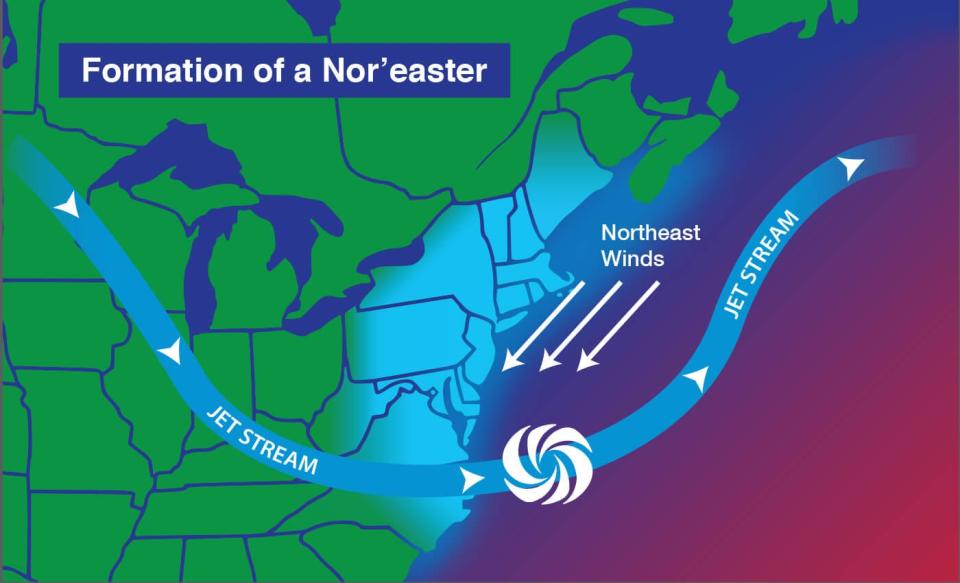What is a nor'easter? Storms can batter East Coast with snow, impact millions of people
The term "nor'easter" is commonly used by forecasters, but what exactly does it mean?
Nor'easters are large, intense areas of low pressure that typically develop off the East Coast during the late fall, winter and early spring.
The storms are called "nor'easters" because they usually bring strong northeast winds over the East as they move north along the Atlantic Coast.
Nor'easters often bring heavy rain, heavy snow and severe coastal flooding to the East.
Some well-known nor’easters include the notorious Blizzard of 1888, the Ash Wednesday storm of March 1962, the New England Blizzard of February 1978, the March 1993 “Superstorm” and the Boston snowstorms of January and February 2015, the National Weather Service said.
Past nor’easters have been responsible for severe economic, transportation and human disruption, and in some cases, disastrous coastal flooding. Damage from the worst storms can easily exceed $1 billion.
WHAT IS WIND CHILL?Understanding the wind chill index and how it's calculated
The heavily populated region between Washington, D.C., Philadelphia, New York and Boston, the so-called I-95 corridor, is especially impacted by nor’easters. Tens of millions of people live in this area.
In a typical nor’easter, the heaviest snow accumulation is usually around 6 to 12 inches, but the more intense storms can produce several feet of snow, WeatherBug said.
Winter nor'easters are most likely to occur in February, followed by January, March, and then December, according to WeatherBug.
WHAT IS THUNDERSNOW?A thunderstorm that can produce snow instead of rain can be just as dangerous

What is the difference between a nor'easter and a blizzard?
A nor'easter can be a blizzard and vice versa.
A blizzard, though, has a specific meteorological definition, according to the National Weather Service: A storm that has blowing and/or falling snow with winds of at least 35 mph, which reduces visibilities to a quarter of a mile or less for at least three hours. In popular usage, however, the term is often used for any heavy snowstorm accompanied by strong winds, the American Meteorological Society said.
Many nor'easters can produce blizzard conditions for a time, especially in New England.
How does a nor'easter form?
As a storm rapidly intensifies, winds blow warm air inland from over the relatively warm Atlantic Ocean water.
At the same time, cold air moves south over the East Coast. This difference in temperature between the warm air over the water and cold Arctic air over the land is the fuel that feeds nor’easters, the Weather Service said.
The combination of warm and cold air can also produce snow, sleet, freezing rain and ordinary rain.
SLEET VS. FREEZING RAIN VS. HAIL: What's the difference?
The exact track of the storm's center determines the dividing line between rain and snow. If the storm moves over the coast or inland just east of the Appalachian Mountains, it will usually push enough warm air inland to bring rain or a wintry mix to the I-95 corridor and the big cities of the Northeast. Snow is then usually confined to the mountains and points west of the mountains.
If the storm moves farther east over the Atlantic Ocean, heavy snow can fall along the I-95 corridor.
Historically, nor'easters that move with an easterly track have brought the East Coast its heaviest snowfalls. If these storms are unusually intense and develop quickly they are known as "bomb cyclones."
WHAT IS A BOMB CYCLONE? How this winter hurricane works

This article originally appeared on USA TODAY: What is a Nor'easter? Storms can batter East Coast with snow, rain

